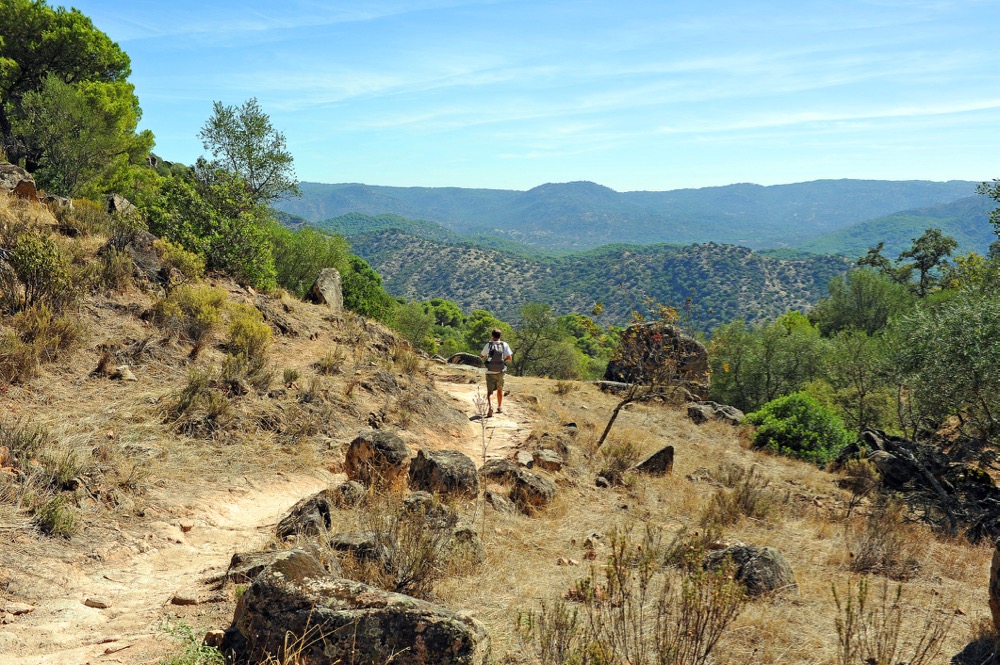
by Jay W. Vogt
My brother and I spent a week in late April on a walking tour of Andalucía, in the south of Spain. We were drawn by its famed ‘pueblos blancos,’ or ‘white villages,’ that are charmingly situated in a vast area of national and natural parks.
Walking vacation the Camino, Spain
Over the last thirteen years, I’ve enjoyed seven walking vacations in Europe, and find them to be a most affordable luxury. A European walking tour/vacation combines pleasures that are individually wonderful and collectively sublime. You can walk all day on public footpaths through beautiful countryside, past historic monuments, carrying only a daypack. You arrive at an intriguing village where a friendly guesthouse, a hot shower, a hearty meal, and a comfortable bed await, along with your suitcase.
For this trip, we chose a seven-night, six-day, self-guided walk organized by a local tour company that provided us with reservations, maps and guide notes.
The walk, called simply the ‘Mountain Walk,’ begins in the lovely mountain town of Gaucin, and follows a mix of public ways, marked and unmarked trails, and even animal paths through valleys, forests, pastures, and mountains, ending at the resplendent town of Ronda – ‘Where you should go,’ Ernest Hemingway wrote, ‘if you ever go to Spain on a honeymoon.’ The walk travels a distance of about 84 kilometers, or 52 miles. That’s an average of 14 kilometers, or 8 miles a day, which may sound like light walking, but still took us most of 6 or 7 hours, with stops, through the mountains.
The first day’s walk travels mostly through agricultural valleys and oak forests, and then rises to the town of Cortes de la Frontera. The second day takes you out the town’s back door into Sierra de Grazalema Natural Park, climbing through wild flowers and gorse over mountain saddles into hidden valleys, and through surreal limestone landscapes, before dropping into the tiny village of Villaluenga del Rosario, home of renowned Payoyo goat cheese.
On the third day you climb the steep cliffs above the town, entering another stunning high mountain landscape, the domain of Griffon Vultures, before crossing over to the town of Grazalema, known as the rainiest town in Spain. On the fourth day, just when you might be ready for a break from the mountains, van der Schaaf’s trail sends you down an old Roman road, through cork forests along a lovely river, to the village of Montejaque. On the fifth day, you return to the mountains, following pastures and forested gullies, to pass through wildly eroded limestone hills, before dropping into the valley again to stay at a guesthouse opposite the Cueva del Gato. The Cave of the Cat is the surging outlet of an underground river, 5 kilometers in length, traveled by intrepid spelunkers in low water season. On the sixth day, you walk along pastoral hills and valleys and approach the magnificent Ronda, with its beautiful old town and dynamic new town connected by a signature bridge over a steep gorge, seeing it the way few tourists ever do, from the fields below its tall cliffs.
We had heavy rains on our first day, so much so that a stream we were to cross became a flash-flooded, swollen river. We watched it stupidly, until the first car we saw that day appeared miraculously and ferried us across. ‘Hoy para mi, manana para ti,’ said the farmer about his kind favor, meaning ‘Today for me, tomorrow for you.’ We encountered powerful bulls numerous times as we walked across pastures, giving them wide berths and blessing their short-sightedness. Our weather in the high country was miraculously cool, dry, and sunny. But we could have just as easily encountered white-out conditions from rain and low clouds, making the trail landmarks very hard to find. We enjoy puzzling our way with maps, but packing a GPS device would have been safer.
The towns along the way are small, charming, and nestled snugly into their mountain terrain. Each is a white village, walls traditionally washed white with limestone to repel the summer’s hot sun. Every guesthouse was pleasant, welcoming, comfortable, and clean. Some, being small hotels, had their own restaurants, typically opening no earlier than 8:30 PM, as is the Spanish way. We took to eating tapas, or small appetizers, in local bars, at an earlier hour.
When walking, you only see what comes your way. What would be a quick detour in a car may add miles and hours to your day. But in Europe, treasures abound along ancient footpaths. Along this walk we visited ruins of Moorish castles, marveled at 30,000 year-old cave paintings in the Cueva de la Paleta, entered 6th century Christian hidden holy places carved from rock, visited magnificent bull rings, and even joined in an ancestral ‘toro de cuerda,’ a running with a roped bull, through old stone streets. If you enjoy slow travel, this walk in Andalucían Spain will challenge and delight you.
Trip Planning
The basic package for this walk, which includes five nights lodging, breakfasts, luggage transfers, and a booklet of maps and walking notes, costs (at the time this was written) $525 euros per person (or $750 US), double occupancy. We added an extra hotel night on either end, transfers to and from Malaga, and packed picnic lunches every day to the basic cost of our trip.
Self-guided walking holidays are a competitive business in Europe, where the practice is common, and you’ll find them priced more like a commodity than a luxury. I plan my flights a year in advance, and buy them with frequent flier miles. Using these strategies, I can get from Boston to Europe and back, and walk for a week, for less than $1,wal000 US.
~ ~ ~ ~ ~
When not walking, Jay W Vogt is President of Peoplesworth, a consulting practice, and author of Recharge Your Team: The Grounded Visioning Approach. Contact him at jay@peoplesworth.com




